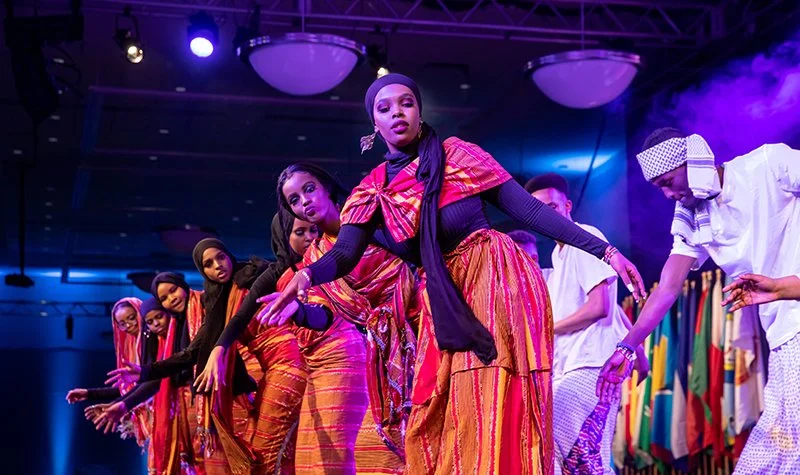The Dhaanto: The Ancient Somali War Dance That Turned Into a National Celebration
By: Chimdindu Ken-Anaukwu
There are dances that entertain you… and then there is the Dhaanto, the Somali dance that grabs your chest and shakes your spirit awake. It’s explosive yet orderly, ancient yet fresh, joyful yet holding the echoes of war chants sung under desert moons. Ask anyone outside Somalia the first time they saw it; their jaw drops. And the deeper you go into its origins, the more you realize: the Dhaanto is not just a dance. It is the story of a people who turned survival into art.
1. The Dhaanto Was Born in War
Before the colored lights, before the wedding halls, before TikTok remixes… the Dhaanto lived on battlefields.
Somali warriors performed it to:
Strengthen courage before battle
Synchronize movement and unity
Send coded messages through poetry and rhythm
Intimidate enemies with booming chants and stomping
Picture it: a line of warriors moving in perfect rhythm, sand rising around their feet, voices echoing across empty plains. This was not entertainment; it was psychological warfare.
And it worked.
The Dhaanto carried the heart of Somali resistance long before Somalia existed as a nation.
2. The Camel Connection: Yes, the Dance Moves Come From Camel Movement
One of the most mind-blowing cultural details for outsiders is that the Dhaanto’s rhythm mirrors the gait of a camel, a sacred animal in Somali culture.
The rising-and-falling bounce of the chest, the forward lean, the gentle tapping… it’s all inspired by the way a camel walks through the desert.
Why?
Because in Somali society:
The camel is wealth
The camel is identity
The camel is beauty
The camel is life itself
So embedding camel movement into dance wasn’t just artistic; it was cultural storytelling, done through the body.
3. When Somalia Fought for Freedom, the Dhaanto Rose Again
During the independence era, Somali artists revived the Dhaanto and turned it from a war dance into a nation-building force.
Suddenly, it wasn’t just for warriors; it was for everyone.
It became the soundtrack of:
Political gatherings
Independence rallies
Cultural renaissance movements
National celebrations
The Dhaanto became the heartbeat of Somali unity, a symbol of a people reclaiming their identity on their own terms.
And that heartbeat still thunders today.
4. From the Desert to Diaspora: The Dhaanto Travels the World
Go to any Somali gathering anywhere on Earth – Minneapolis, Toronto, Nairobi, London, or Dubai – and wait for the music to start.
When the first Dhaanto beat drops:
Aunties turn into professional choreographers
Uncles throw away their dignity
Cousins who “don’t dance” magically know the steps
Kids form competitive circles within seconds
The diaspora performs it with the same passion as those in the Horn. It's one of the few cultural elements that never dies, no matter how far from home Somalis travel.
This dance is a homing beacon.
5. Why the Dhaanto Is One of the Most Fascinating Dances on Earth
Most cultures have war dances.
Most cultures have celebratory dances.
Most cultures have national dances.
But the Dhaanto is all three in one, and that alone makes it rare.
It is:
A war-time morale booster
A love-language dance at weddings
A national symbol of unity
A rhythmic archive of Somali poetry
A living tradition that spans centuries
It is fierce.
It is joyful.
It is ancient.
It is modern.
It is Somali.
And that is why people outside Somalia can’t believe how much history and spirit can be packed into one dance.
FAQs
1. Is the Dhaanto difficult to learn?
Not at all; even beginners can join after a few steps. The point is rhythm and unity.
2. What music is used for the Dhaanto?
Fast-paced Somali folk beats with strong percussion and poetic lyrics.
3. Do all Somalis dance the Dhaanto?
Yes. Even the shy ones. Even the serious uncles.
4. Why is it important culturally?
It reflects Somali history, resilience, humor, and nomadic lifestyle.
5. Where can I see real Dhaanto performances?
Somali weddings, cultural festivals, and countless diaspora events around the world.
Want to dive deeper into Somali culture and learn the Somali language with context, emotion, and real-life meaning?
Download NKENNE, where African languages live, dance, and thrive.



